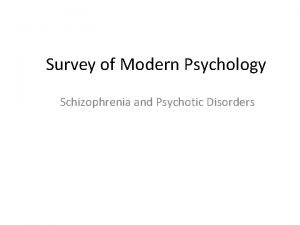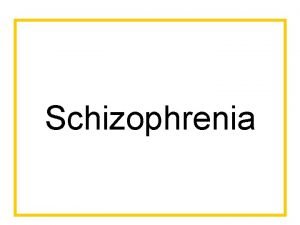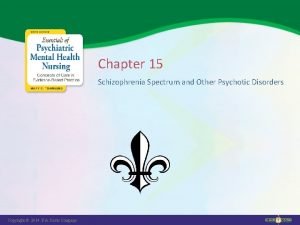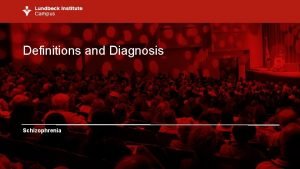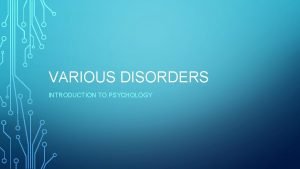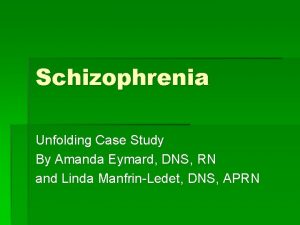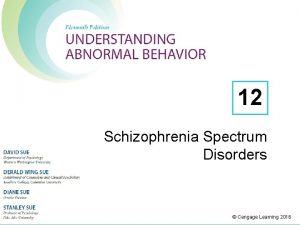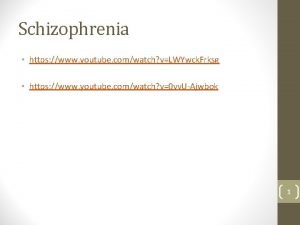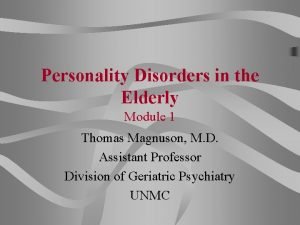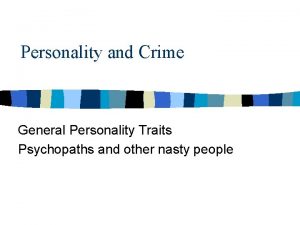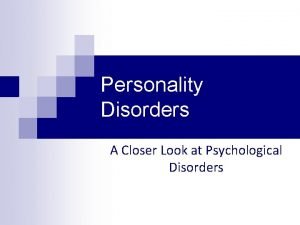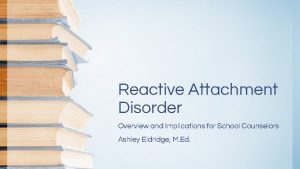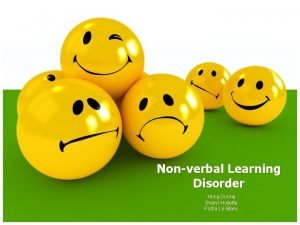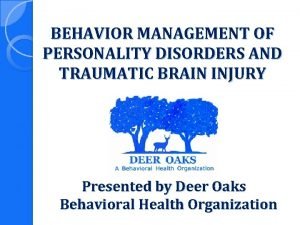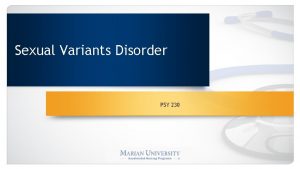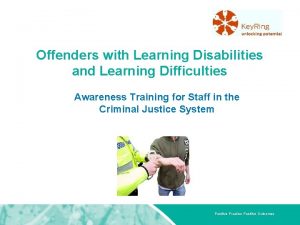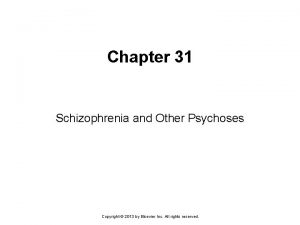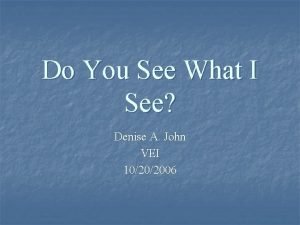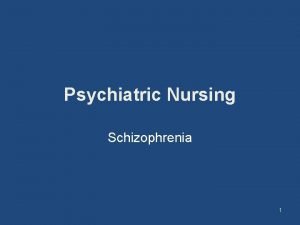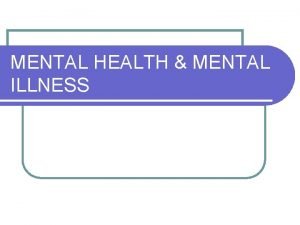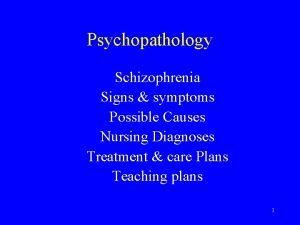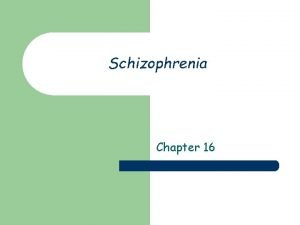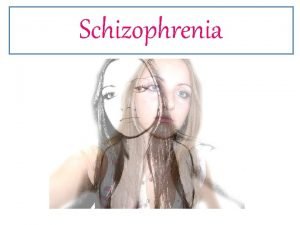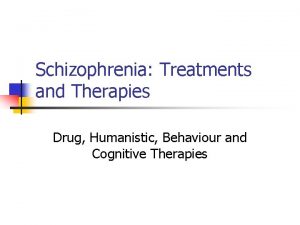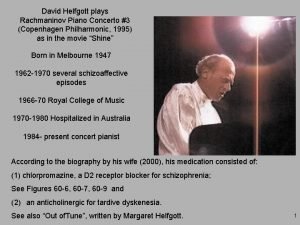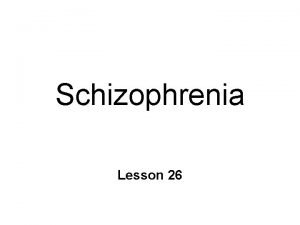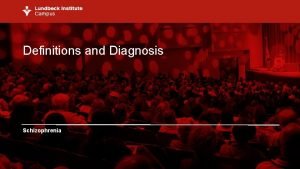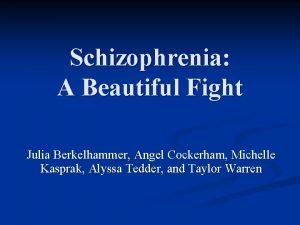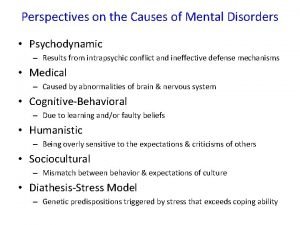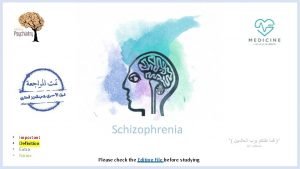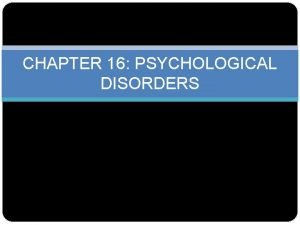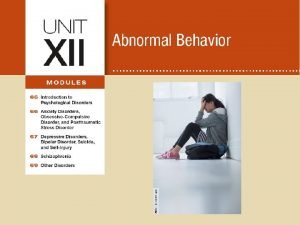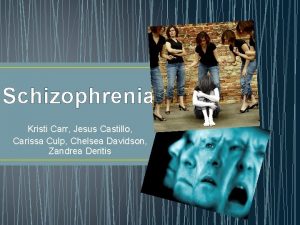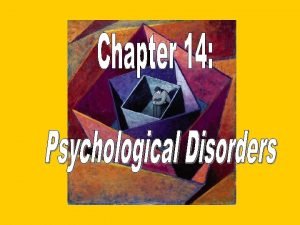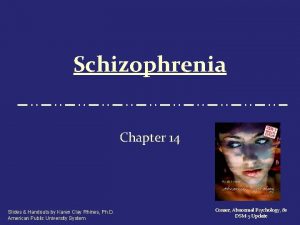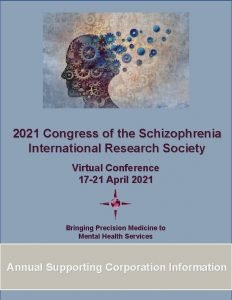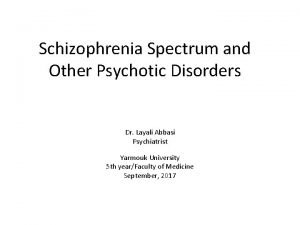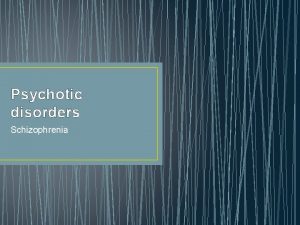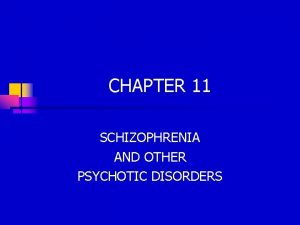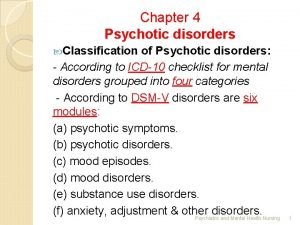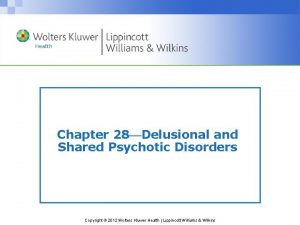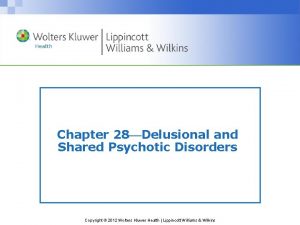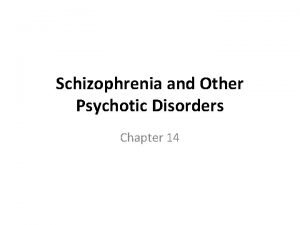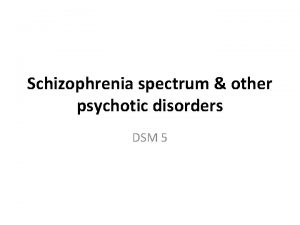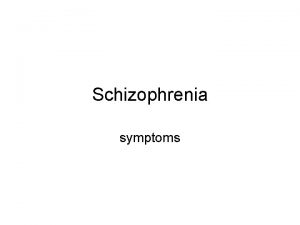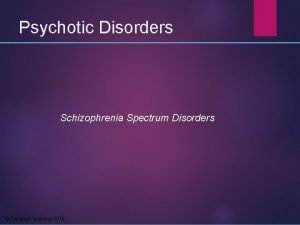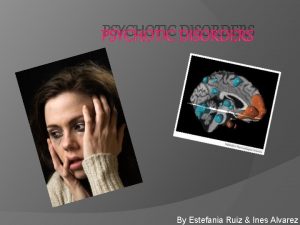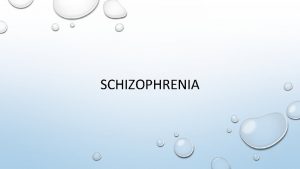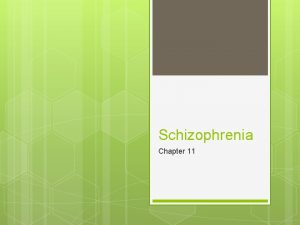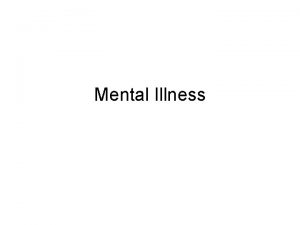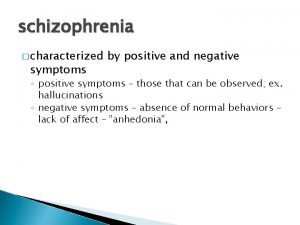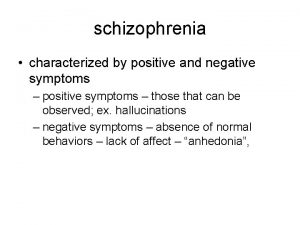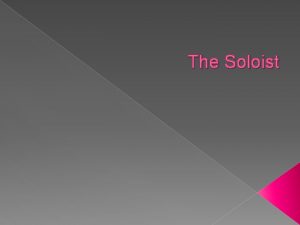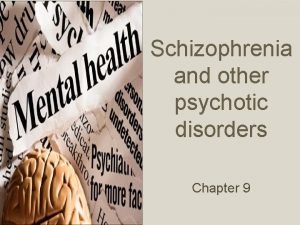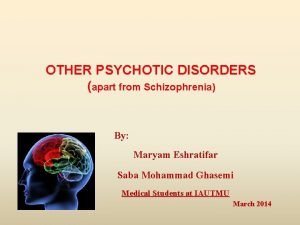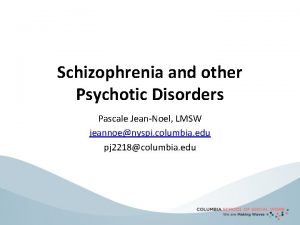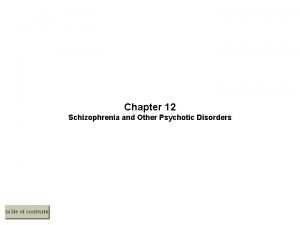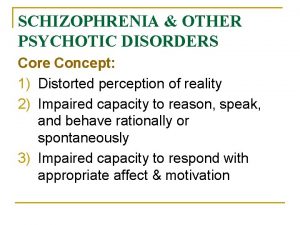Psychotic Disorders Schizophrenia Delusional Disorder Schizophrenia Positive Symptoms

















































- Slides: 49

Psychotic Disorders • Schizophrenia • Delusional Disorder

Schizophrenia Positive Symptoms: • Symptoms found in schizophrenics Negative Symptoms: • Normal behaviors that are absent in schizophrenics

Positive Symptoms • Hallucinations(mostly auditory) • Delusions(delusions of grandeur and persecution are most common) • Speech disturbances(including word salad) • Disorganized behavior(including silliness, weird motor behaviors) • Inappropriate affect(emotional responses that are inappropriate for the circumstances, such as crying at comedy shows)

Negative Symptoms • Social withdrawal, limited speech and action, poor hygiene, apathy • Flat affect (no emotional response at all)




Schizophrenia Types Disorganized: • Inappropriate affect & actions • Incoherent verbal behavior & silliness • Delusions & hallucinations

Schizophrenia Types Catatonic: • Periods of frenzied activity alternating with periods of immobility • May stay in odd positions for hours

Schizophrenia Types Paranoid: • Delusions of grandeur • Delusions of persecution • Usually harmless, but may become violent if threatened

Schizophrenia Types Undifferentiated: • Used to describe schizophrenics with mixed or unusual symptoms

Causes • Brain Abnormalities • Excessive Dopamine Activity • Stress

Brain Abnormalities Some schizophrenics have: • Low frontal lobe activity • Undersize hippocampus, amygdala, or thalamus • Larger than normal ventricles


Excess Dopamine • 2/3 of schizophrenics improve when given dopamine reducers • PET scans show excess dopamine activity in sufferers • Drugs that increase dopamine cause schizophrenic symptoms • People taking excessive L-dopahave schizophrenic symptoms

Genetic Aspects • Schizophrenia runs in families • Concordance is higher among closer relatives


Treatments • Anti-psychotic drugs such as Phenothiazines, Butyrophenones used to reduce dopamine levels • Stress reduction also appears helpful • Psychotherapy


Anxiety Disorders • Panic disorders • Phobias • Post Traumatic Stress Disorder (PTSD) • Obsessive Compulsive Disorder (OCD)

Panic Disorder • Intense, short-lived, recurring attacks of overwhelming anxiety or terror • May involve the limbic system


Phobias • Phobia: an unreasonable, excessive, or irrational fear • To be a phobia, there must be great distress or major interference with life

Phobias -Specific: fear of a specific object, place, or event 1. situational phobias (elevator, airplane) 2. natural environment (water, height) 3. blood-injection-injury 4. animal phobias (dogs, snakes)

Phobias -Social Phobias: • fear of embarrassing or humiliating oneself in front of others (public speaking, eating in public places, writing in front of others) • Lead to avoidance of social situations

Phobias -Agoraphobia • "Fear of the marketplace" • Marked by intense fear when isolated in open spaces or in crowds • May develop after panic attacks. • The person may become “Housebound”.


Systematic Desensitization • Teach subject to relax • Create a hierarchy of feared situations, from least to most • Work through situations, while maintaining relaxation


Modeling • Provide a role model who does not show the fear • To be effective, the role model must be seen as like the person with the fear

Phobias: Group Therapy • People with the same phobia often treated together • Thus, patients with milder fears serve as role models for those with more severe fears

Obsessive Compulsive Disorder • Obsessions: persistent, uncontrollable thoughts • Compulsions: ritualistic acts one feels compelled to perform


Biology & O-C Disorders • OCD patients show excessive functioning in the frontal lobes & the limbic system • OCD patients show serotonin imbalances that respond to depression medications

Somatoform Disorders • Hypochondriasis • Body Dysmorphic Disorder • Conversion Disorder • Pain Disorder • Somatization Disorder

Somatoform Disorders Real physical symptoms with no biological cause: • Hypochondriasis: – Excessive attention to state of health, along with preoccupation with the minor aches and pains of living. may "doctor shop". • Conversion: – Physical symptoms, such as paralyses and blindness, with no physical explanation Treatment: Psychotherapy and sometimes medication

Personality Disorders • Antisocial Personality Disorder

Personality Disorders • Antisocial Personality Disorder – Marked by a lack of empathy, chronic underarousal, willingness to lie, cheat, steal, and break the law

Antisocial Personality Disorder Pattern begins in childhood or early adolescence. Possible Causes: • emotional deprivation in childhood, • Observational learning, • problem in moral development, • genetic and biological factors

Sexual Disorders • Includes sexual dysfunctions and paraphilias • Only dysfunctions ¶philias causing distress to self or others are disorders

Paraphilias • Voyeurism: Sexual attraction to watching unconsenting people nude or engaged in sexual activity • Fetishism: Sexual attraction to inanimate objects • Pedophilia: Sexual attraction to prepubescent children

Paraphilias • Exhibitionism: Sexual attraction to exposing one's genitals to unsuspecting strangers • Masochism: Sexual attraction to being bound, beaten, or made to suffer • Sadism: Sexual attraction to hurting others

Paraphilias • Many arise through classical conditioning • Most are strengthened when the person fantasizes the attraction while masturbating

Personality Disorder Treatment varies for the person and disorder, but generally: • Psychotherapy • Medications – Antidepressant medications. Antidepressants may be useful if you have a depressed mood, anger, impulsivity, irritability or hopelessness, which may be associated with personality disorders. – Mood-stabilizing medications. As their name suggests, mood stabilizers can help even out mood swings or reduce irritability, impulsivity and aggression. – Anti-anxiety medications. These may help if you have anxiety, agitation or insomnia. But in some cases, they can increase impulsive behavior. – Antipsychotic medications. Also called neuroleptics, these may be helpful if your symptoms include losing touch with reality (psychosis) or in some cases if you have anxiety or anger problems. • Hospitalization or Residential Care

Other DSM-IV disorders. . SLEEP DISORDERS Disorders which are characterised by a significant sleep disturbance. Examples include: • Primary Insomnia – difficulty getting to sleep or staying asleep • Narcolepsy – irresistible attacks of refreshing sleep • Sleep Terror Disorder – repeated occurrence of sleep terrors (awakenings from sleep usually beginning with a panicky scream or cry)

Other DSM-IV disorders. . INFANCY, CHILDHOOD OR ADOLESCENT DISORDERS Disorders which are usually first diagnosed in infancy, childhood or adolescence. Examples include: • Reading Disorder – reading achievement that is below that expected given the individual’s chronological age • Stuttering– a disturbance in the normal fluency and time pattering of speech • Encopresis – the repeated passage of faeces into inappropriate places (e. g. clothing or floor).

Other DSM-IV disorders. . DISSOCIATIVE DISORDERS Disorders in which there is a disruption in the usually integrated functions of consciousness, memory, identity or perception of the environment. Examples include: • Dissociative Identity Disorder – the presence of two or more distinct identities/personalities within the same individual • Dissociative Amnesia– an inability to recall important personal information, usually of a traumatic/stressful nature

Other DSM-IV disorders. . IMPULSE-CONTROL DISORDERS Disorders in which there is a failure to resist an impulse, drive or temptation to perform an act that is harmful to the person or to others. Examples include: • Kleptomania – the recurrent failure to resist impulses to steal objects not needed for personal use or monetary value • Pyromania– a pattern of fire setting for pleasure, gratification or relief of tension • Pathological gambling – recurrent and persistent maladaptive gambling behaviour

Other DSM-IV disorders. . DELIRIUM, DEMENTIA AND AMNESTIC & OTHER COGNITIVE DISORDERS Disorders in which there is a significant deficit in cognition or memory. Examples include: • Delirium – a disturbance of consciousness • Dementia– multiple cognitive deficits that include impairment in memory (e. g. Alzheimer’s)
 Catatonic behavior
Catatonic behavior Thought insertion
Thought insertion Looseness of association
Looseness of association Dsm 5 vs dsm 4
Dsm 5 vs dsm 4 Delusional thinking
Delusional thinking Schizophrenia unfolding case study answers
Schizophrenia unfolding case study answers Chapter 12 schizophrenia spectrum disorders
Chapter 12 schizophrenia spectrum disorders Chapter 12 schizophrenia spectrum disorders
Chapter 12 schizophrenia spectrum disorders Symptoms of schizophrenia
Symptoms of schizophrenia Cluster c
Cluster c Difference between psychosis and neurosis
Difference between psychosis and neurosis Qualities of a psychopath
Qualities of a psychopath Dsm 5 munchausen by proxy
Dsm 5 munchausen by proxy Paranoid pd
Paranoid pd Reactive attachment disorder symptoms
Reactive attachment disorder symptoms Nvld
Nvld Obsessive-compulsive personality disorder test
Obsessive-compulsive personality disorder test Orgasmic dysfunction
Orgasmic dysfunction Did
Did Breast tenderness early pregnancy
Breast tenderness early pregnancy Mesolimbic
Mesolimbic Positive practice positive outcomes
Positive practice positive outcomes Staphylococcus shape
Staphylococcus shape What's 8 + 5
What's 8 + 5 Chapter 31 schizophrenia and other psychoses
Chapter 31 schizophrenia and other psychoses See
See Nursing care plan hallucinations
Nursing care plan hallucinations Axis 1-5 mental health
Axis 1-5 mental health Nursing diagnosis for schizophrenia
Nursing diagnosis for schizophrenia Schizophrenia disorganized behavior
Schizophrenia disorganized behavior Statistics of schizophrenia
Statistics of schizophrenia Humanistic approach to schizophrenia
Humanistic approach to schizophrenia Genes schizophrenia
Genes schizophrenia Undifferentiated schizophrenia
Undifferentiated schizophrenia Loose associations
Loose associations Dsm 5 vs dsm 4
Dsm 5 vs dsm 4 Schizophrenia
Schizophrenia Double bind
Double bind Loose associations
Loose associations Hebephrenic schizophrenia
Hebephrenic schizophrenia Is schizophrenia genetic
Is schizophrenia genetic Avolition definition schizophrenia
Avolition definition schizophrenia Schizophrenia def
Schizophrenia def Module 68: schizophrenia
Module 68: schizophrenia Kristi carr
Kristi carr Example of loose associations in schizophrenia
Example of loose associations in schizophrenia Acute schizophrenia
Acute schizophrenia Loose associations psychology
Loose associations psychology Sirs conference 2021
Sirs conference 2021 Dopamine pathway schizophrenia
Dopamine pathway schizophrenia
